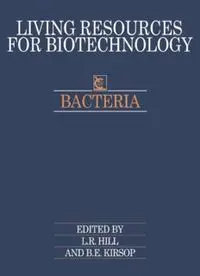
Bacteria (Living Resources for Biotechnology) PDF
Preview Bacteria (Living Resources for Biotechnology)
This volume is a unique international compilation for biotechnologists of data on the source and use of bacterial cells. The volume provides details of the location and scope of major culture collections around the world holding bac- teria; information is given on how to access their data, administration and safety, identification, culture, preservation, patents, specialist services and international organisations. The authors are international authorities who have combined with the resource centres to provide a source book for microbiolog- ists in industry, research establishments and universities. An international initiative by the World Federation for Culture Collections, with financial support from UNESCO LIVING RESOURCES FOR BIOTECHNOLOGY Editorial Board: A. Doyle D. L. Hawksworth L. R. Hill B. E. Kirsop (Senior Editor) K. Komagata R. E. Stevenson Bacteria Titles in the series Animal cells Bacteria Filamentous fungi Yeasts LIVING RESOURCES FOR BIOTECHNOLOGY Bacteria Edited by L. R. Hill and B. E. Kirsop The right of the University of Cambridge to print and sell all manner of books was granted by Henry VIII in 1534. The University has printed and published continuously since 1584. CAMBRIDGE UNIVERSITY PRESS Cambridge New York Port Chester Melbourne Sydney CAMBRIDGE UNIVERSITY PRESS Cambridge, New York, Melbourne, Madrid, Cape Town, Singapore, Sao Paulo Cambridge University Press The Edinburgh Building, Cambridge CB2 2RU, UK Published in the United States of America by Cambridge University Press, New York www.cambridge.org Information on this title: www.cambridge.org/9780521352246 © Cambridge University Press 1991 This publication is in copyright. Subject to statutory exception and to the provisions of relevant collective licensing agreements, no reproduction of any part may take place without the written permission of Cambridge University Press. First published 1991 A catalogue record for this publication is available from the British Library Library of Congress Cataloguing in Publication data Bacteria/edited by L. R. Hill and B. E. Kirsop. p. cm. - (Living resources for biotechnology) Includes bibliographical references Includes index. 1. Bacteria - Type specimens - Catalogs and collections. 2. Bacteria - Type specimens - Catalogs and collections - Directories. 3. Biotechnological microorganisms - Catalogs and collections - - Directories. I. Hill, L. R. (Leslie Rowland), 1935- II. Kirsop, B. E. III. Series. [DNLM: 1. Bacteria. 2. Biotechnology. QW 4 B1303] QR64.5.B33 1990 660'.62-dc20 90-2024 CIP ISBN-13 978-0-521-35224-6 hardback ISBN-10 0-521-35224-X hardback Transferred to digital printing 2005 CONTENTS Contributors ix Series introduction xi Preface xiii 1 Resource centres L. R. Hill, K. Komagata and R. L. Gherna 1 1.1 Nature of the resource 1 1.2 Biotechnological applications 2 1.3 Types of resource centres 3 1.4 Future development of resource centres 20 1.5 Reference 21 2. Information resources M. I. Krichevsky and H. Sugawara 22 2.1 Introduction 22 2.2 Information needs 23 2.3 Information resources 28 2.4 Access to data resources 46 3 Administration and safety L. R. Hill and R. L. Gherna 49 3.1 Administration 49 3.2 Safety 54 3.3 References 61 4 Culture and maintenance L. R. Hill, M. Kocur and K. A. Malik 62 4.1 Culture 62 4.2 Maintenance 64 4.3 Quality control 77 4.4 Records 78 4.5 Security 78 4.6 References 78 vn viii Contents 5 Identification L. R. Hill, K. A. Malik and K. Komagata 81 5.1 Introduction 81 5.2 Practical aspects of identification 86 5.3 Chemotaxonomy 89 5.4 Nucleic acids 91 5.5 Selected references for identification 93 6 Patent protection for biotechnological inventions LJ. Bousfield 95 6.1 Introduction 95 6.2 Basis of the patent system 95 6.3 Kinds of biotechnological inventions 97 6.4 Patentability of biotechnological inventions 98 6.5 Practical considerations 110 6.6 Further reading 131 7 Culture collection services D. Allsopp and F. P. Simione 134 7.1 Introduction 134 7.2 Types of services 134 7.3 Workshops and training 141 7.4 Publications, catalogues and publicity material 142 7.5 Fes and charges 143 7.6 Suggested reading 14 8 Organisation of resource centres B. E. Kirsop and E. J. DaSilva 146 8.1 Introduction 146 8.2 International organisation 146 8.3 Regional organisation 156 8.4 National federations/commitees 158 8.5 Future developments 159 Index 162 CONTRIBUTORS Allsopp, D. CAB International Mycological Institute, Ferry Lane, Kew, Surrey TW9 3AF, UK (Chapter 7) Bousfield, I. J. National Collections of Industrial and Marine Bacteria Ltd, 23 St. Machar Drive, Aberdeen AB2 1RY, UK (Chapter 6) DaSilva, E. J. United Nations Educational Scientific and Cultural Organisation, Division of Scientific Research and Higher Education, 7 Place de Fontenoy, F-75700 Paris, France (Chapter 8) Gherna, R. L. American Type Culture Collection, 12301 Parklawn Drive, Rockville, Maryland 20852, USA (Chapters 1, 3) Hill L. R. National Collection of Type Cultures, Central Public Health Laboratory, 61 Colindale Avenue, London NW9 5HT, UK (Chapters 1, 3, 4, 5) Kir sop, B. E. Microbial Strain Data Network, Institute of Bio- technology, Cambridge University, 307 Huntingdon Road, Cambridge CB3 OJX, UK (Chapter 8) Kocur, M. Czechoslovak Collection of Microorganisms, Masaryk University, Jostova 10, Brno 66243, Czechoslovakia (Chapter 4) Komagata, K. Hakusan 1-5-10-503, Bunkyo-ku, Tokyo 114, lapan (Chapters 1, 5) Krichevsky, M. I. Microbial Systematics Division, National ix
